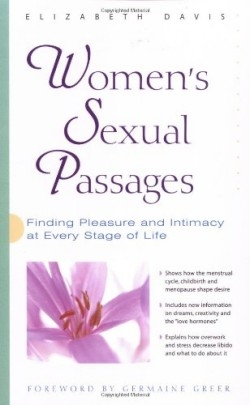Women's Sexual Passages
Finding Pleasure and Intimacy at Every Stage of Life
The idea that a woman’s romantic feelings might be due more to “biological promptings” than to her swain’s sweet talk is just one of the many observations offered in a book that represents women’s sexuality as a masterful choreography between body and mind. It is only when social constructs, such as cultural myths denigrating to women, interfere with Mother Nature that the dance becomes a tortured tango instead.
Midwife, health care provider, and educator for over twenty years, Davis mandates that women re-affirm “blood mysteries” like menarche, birth, and menopause as integral aspects of their sexuality as well as “vehicle[s] for vision.” In an effort to help women reclaim and work with their “natural rhythms of desire,” she presents an informative and provocative treatise that discusses both the physiological and psychological changes accompanying these transformative events.
That she writes appealingly to women is evident in her approach, which she terms both feminist and feminine. Noting that brain evolution studies show women more adept in contextual and relational thinking than men, Davis herself pulls in and links information from all fields, including her and her clients’ observations, the results of recent research on gender-specific traits and their often negative societal effects, as well as information from other cultures, notably Native American, in which “femaleness” is celebrated in rites and ceremonies, some of which are described in-depth.
As a result, the book is never boring. In dispelling the myth that the female body is “a passive vessel for male pleasure,” she presents documented results of a scientific study showing the female egg to be, instead, chemically selective. In her chapter on hormones, Davis notes that women on the Pill often choose men more for their ability to protect than their suitability for mating since the Pill alters natural hormonal levels, fooling the body, and subsequently the mind, into feeling and thinking like a pregnant woman.
Davis is frank in discussing men, such as how they may feel threatened and angry when women limit their “role” as nurturers. Nevertheless, her solution is not to bash or feminize men, since “as our differences diminish, so will the attraction.” Instead, she suggests “circling” as a means of support, i.e., sharing insights with other women.
The book scores as both a handbook for women of all ages who wish to understand the synergy between the body and spirit; and a guidebook for women hoping to find ways to integrate their rhythmic nature into a society that often just won’t dance.
Reviewed by
Judy Hopkins
Disclosure: This article is not an endorsement, but a review. The publisher of this book provided free copies of the book to have their book reviewed by a professional reviewer. No fee was paid by the publisher for this review. Foreword Reviews only recommends books that we love. Foreword Magazine, Inc. is disclosing this in accordance with the Federal Trade Commission’s 16 CFR, Part 255.

